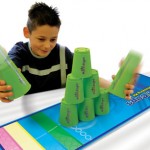PEER Teaching in the Gym
A Successful Activity in the gym: has most students engaged and their mood is lifted by music, physical activity, and positive relationships with their classmates.
Gym Homes and Color Teams:
Since we have the gym homes set up for this class, this is generally the best place to have your students sit for instructions. When you are teaching or even student teaching, you would be wise to create gym homes and color teams for them. If you go to this much trouble, you might also consider organizing your classroom with the same format. I do balance the color teams with an equal number of boys and girls on each team,
Music:
Music has the ability to change the mood of a class. It is also a great way to nonverbally signal when an activity begins or ends. It has untapped potential in assisting with management in the classroom too. When you want students to put everything away and be ready for transition, use a 30 second song. Then the song is running your class and not the teacher. Also, it’s a good stress manager for the teacher if you like the music too!
Tag Games:
Make sure all tag games have a way for students to get back in the game after the tag. This is essential for creating a fun atmosphere, because students aren’t just getting each other out, they are getting them back in the game. Partner tag games may have the highest level of participation and many require no equipment. Also, if you have old stuffed animals, they make for very popular taggers.
Here’s the color scheme that we use in the gym, It is also used by the major P.E. suppliers, so you can often have equipment that is the same color as the teams, which makes for much easier transitions.
|
Blue
|
Orange
|
Yellow
|
Green
|
Purple
|
Red
|
When You’re teaching: Connecting to previous experiences improves the pace of understanding:
When teaching in the gym it is helpful to connect a new activity to a previous one. It makes for quicker understanding. For example you might say, “You remember when we held a parachute in a circle in the center of the gym. Let’s make a circle about the same size”.
When teaching university students, we also have many common experiences during the term, so when you are peer teaching it will lead to quicker understanding if you can refer to a previous game or activity that has some similar attributes. This is one reason why student teaching is more difficult than your first year of teaching (though obviously much shorter). When you are student teaching you do not have the common learning experiences that the regular teacher has with the class. So it’s hard to overcome student comments like, “That’s not how the teacher does this”. When you have your own classroom you are connected to everything that happens and you will be better able to build off of previous learning.
Demonstration:
When you’re teaching in the gym it often helps to have a small group of students do a demonstration. It is amazing how seeing (nonverbally) the activity in action improves the understanding of the activity or game. If it’s a tag game you should visually demonstrate the two-finger peace tag on the back of a classmate. For additional reinforcement you may want to have everyone in class show the teacher how you tag people.
Classroom and P.E. Nonverbals:
If you find yourself repeated a verbal directive, look for a way to change it to a nonverbal. If you excuse students from class by saying the name of a group, just write the name on a piece of tag paper and hold it up instead. In our gym we put the color team names on the wall and use a laser pointer to point and excuse them. It’s quieter and kids respond more quickly to visual information and something that is unique, like a laser pointer.


